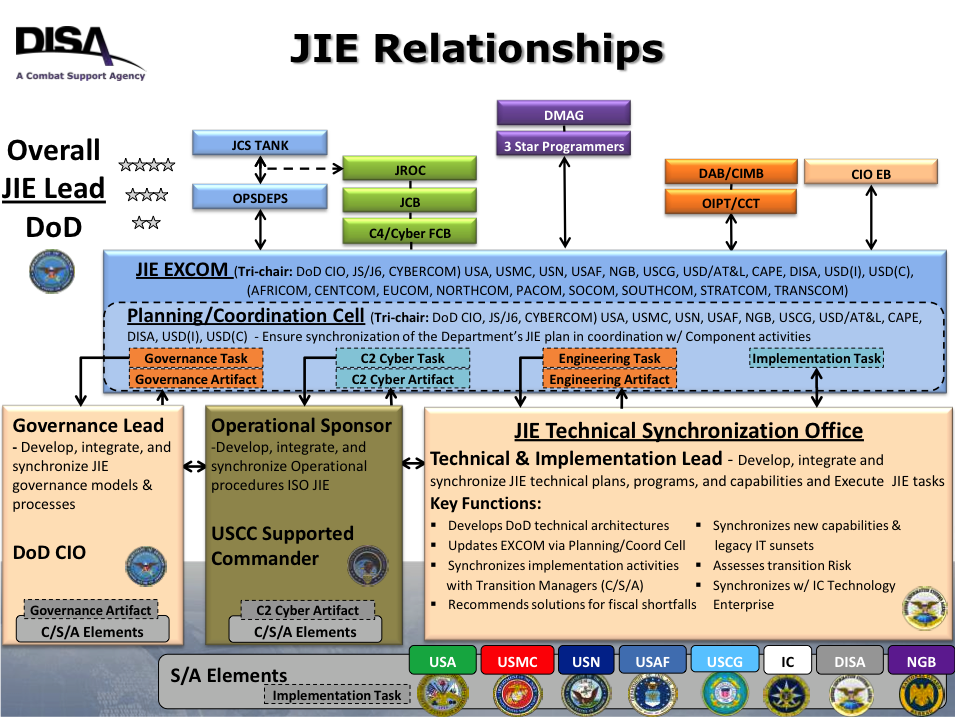By ChrisScott
As we go about our daily activities, we interact with each other through a complex web of relationships that we have developed over years of co-existing with friends, family, colleagues, etc. I trust that the shoes I just bought will mostly keep my feet dry as long as I don’t jump in any puddles. I trust that my milk will taste good up until near the expiration date. Mostly, we don’t even know these expectations and trust relationships exist; they just do. And they are constantly reevaluated and renegotiated on an almost subconscious level.
In a military setting, these types of trust relationships are scrupulously analyzed, rigorously detailed, agreed upon in writing ahead of time, codified in OPLANS, organized via Task Forces, and practiced in joint and coalition exercises (some “tabletop” or paper-exercises, and some at-sea or boots-on-the-ground exercises with real people and real stuff). To truly understand how/if JIE will have an impact on the warfighter’s capability, we need to look at how the trust relationships are being organized.
In my experience, this is usually the area where DISA falls flat. It shouldn’t be that hard, but it is. Putting together some enforceable standards, specifications, common tactics, techniques and procedures (TTPs) take a bit of time, cooperation and technical understanding, and DoD does it all the time. But as anyone who works with DoD knows, military sub-commands reorganize just about every time a new flag officer is appointed (every two-three years). The programs, however, are funded on an exhaustive multi-year Program Objective Memorandum or POM cycle. And technologies are changing at a rapid rate; constantly dumping game-changing technical advances on us in the middle of a program deployment. Keeping the “who does what to/with who” in tact throughout all of this can be tricky.
Last October, the Deputy Secretary of Defense established the Deputy’s Management Action Group (DMAG) to be his enforcement arm to execute a common management approach. Since there never really are NEW organizations in DoD, he merged a number of other senior leadership groups (a consolidation) to create a new framework of governance. Sounds good?
Here’s a slide from a recent DISA briefing (NOV2012) on how JIE Relationships will work. The JIE Executive Committee (or EXCOM) alone consists of: (Tri-chair: DoD CIO, JS/J6, CYBERCOM) USA, USMC, USN, USAF, NGB, USCG, USD/AT&L, CAPE, DISA, USD(I), USD(C), (AFRICOM, CENTCOM, EUCOM, NORTHCOM, PACOM, SOCOM, SOUTHCOM, STRATCOM, TRANSCOM). The “Planning/Coordination” Cell will consist of: (Tri-chair: DoD CIO, JS/J6, CYBERCOM) USA, USMC, USN, USAF, NGB, USCG, USD/AT&L, CAPE, DISA, USD(I), USD(C).

Looking at the above and trying to deduce how the TTPs will be developed, funded, enforced, exercised, etc. is not easy. As I’ve said in previous posts on this subject (Here on the JIE and its teeth), I am an optimist and consider the effort to be well worth the desired results. But the larger a DoD effort is, the more difficult it is to keep these interdependencies (trust relationships and expectations) in tact. I applaud the effort and wish DISA the best in pulling it off.

Leave a Reply
You must be logged in to post a comment.